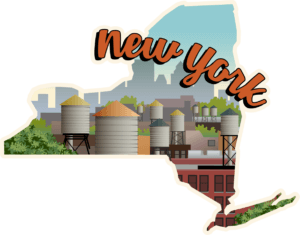This blog was last updated on January 11, 2021
Many states have started making changes to how they collect and remit state and local sales tax following the South Dakota v. Wayfair, Inc. decision. However, the New York economic nexus changed more quickly than others. New York made its enforcement date June 21, 2018 – the same day as the Wayfair ruling. The state also initially set its sales threshold at $300,000, but has since adjusted that to $500,000. Below, we outline some of the larger points to New York’s sales and use tax nexus guidance.
Enforcement date: 
June 21, 2018.
Sales/transactions threshold:
$500,000 and 100 transactions.
Measurement period:
The previous four sales tax quarters.
Included transactions/sales:
Retail sales of tangible personal property delivered into the state. Sales made through a registered marketplace facilitator are not included, but sales made through a non-collecting marketplace are included.
When You Need to Register Once You Exceed the Threshold:
Within 30 days after meeting the threshold, begin to collect tax 20 days afterwards.
Summary: A business that has no physical presence in New York is required to register as a sales tax vendor and collect and timely remit the applicable state and local sales tax if in the immediately preceding four sales tax quarters it has made more than $500,000 in sales of tangible personal property delivered in the state, and conducted more than 100 sales of tangible personal property delivered in the state. The sales tax quarters are: March 1 through May 31, June 1 through August 31, September 1 through November 30, and December 1 through February 28/29. Additionally, the New York Department of Taxation and Finance states that “a business with no physical presence in the state that registered for sales tax because of the Tax Law provisions…and, in good faith, collected and remitted sales tax at an incorrect local rate, must pay the additional local sales tax due but is not liable for penalty and interest on the additional local tax. This relief applies only to sales made during the first four quarterly periods after the business was required to register.”
New York has continued to make small adjustments to its economic nexus laws, even in the wake of the Wayfair decision. But remote sellers and marketplace facilitators do not need to operate in a constant state of distress. We have the right experts to help with your sales and use tax process.
New York Sales Tax Resources: For more information contact our team. Or, swing on over to our interactive sales tax nexus map and read the most up-to-date information on other states.
Take Action
Check out our workshop on how to file your New York state sales tax return.